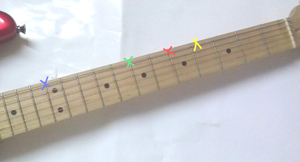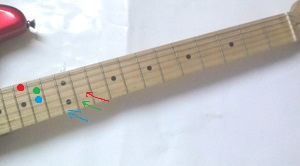In this section of this website there are some explanations about several "coincidences" of things that happen because the fundamentals of Physics and they are "influential" in Music.
Formation of chordsPhysics is not only in basic facts of music like strings vibration, reberberation of resonance boxes or the acoustics of certain place but also in the rules establishment to form the different kinds of chords that exist. Chords are gropus of notes that are played at the same time and are separated from each other by certain distances (that are measured in tones and semi-tones) complying with some specified established rules to form the different kinds of chords that exist such as major, minor, 5 chords, etc...Harmony is a Conservatoire subject that studies the formation of chords and the relation between them. But, why chords were formed like that, major chords in particular?
Harmonics are a physics phenomenon, a special sound that it only appears (in a natural way) at the half, third, fourth and fifth part of the strings length. In guitar you can easily find them at the 12th, 7th and 5th frets (in the frets themselves) and between the 3rd and 4th frets (closer the 4th, see the yellow mark on the photo). The harmonics sound when you toch in those frets without pressing only rub. In other places of the guitar that are not at the half, the third, fourth and fifth part of the string length there aren't harmonics.

Then if you put together all the notes that these harmonics produce you can form major chords.
For example in the 6th string of the guitar, that open it's "E" you get these harmonics: at 12th fret "E", 7th traste "B", 5th traste "e" and between the 3rd and the 4th fret "g #" that are the notes of the chord E Major repiting the note that gives the name to the chord, "E" one lower and the other higher.
In the 5th string, that open is an "A" you get: at 12th fret "A", 7th traste "e", 5th traste "a" and between the 3rd and the 4th fret "c #" that are the notes of the chord A Major repiting the note that gives the name to the chord, "A" one lower and the other higher.
In the 4th string, that open is a "D" you get: at 12th fret "D", 7th traste "a", 5th traste "d" and between the 3rd and the 4th fret "f #" that are the notes of the chord D Major repiting the note that gives the name to the chord, "D" one lower and the other higher.
In the 3rd string, that open is a "G" you get: at 12th fret "G", 7th traste "d", 5th traste "g" and between the 3rd and the 4th fret "b" that are the notes of the chord G Major repiting the note that gives the name to the chord, "G" one lower and the other higher.
In the 2nd string, that open is a "B" you get: at 12th fret "B", 7th traste "f #", 5th traste "b" and between the 3rd and the 4th fret "d" that are the notes of the chord B Major repiting the note that gives the name to the chord, "B" one lower and the other higher.
The 1st string is also "e" and produces the same harmonics than the 6th.
Now we "have" D Major, E Major, G Major, A Mayor and B Major. To "get" the rest we could tune the guitar differently for example to get "C Major" we just have to tune the 4th string one tone lower so open would sound like "C" and then get at 12th fret "C", 7th traste "g", 5th traste "c" and between the 3rd and the 4th fret "e" that are the notes of C Major repiting the note that gives the name to the chord, "C" one lower and the other higher.
The question is: is it possible that chords where formed like that for a physics reason that makes they sound good to us?
Sympathy ResonanceAnother physics phenomenon that affects music is the Sympathy Resonance that happens in the strings of the guitar. Could the strings of one guitar sound by themselves without anyone playing?. Yes. When playing further than the 5th fret you "reach" the notes of the following string, for example if you play the 5th string at the 5th fret sounds like the 4th string open because both notes are the same one a "D" at the same height. When the sound its the same the other string vibrates spontaneously. That could be seen very clearly when playing the 6th string at the 15th fret (see red mark on the photo): that sound is a "g" and the 3rd string (marked with a red arrow) will vibrate by itself without any help since open is also a "g" at the same height: the same "g".

Likewise if you play the 5th string at the 14th fret (marked with a green spot in the photo) the sound is a "b" just the same as the 2nd string open (marked with a green arrow) that will vibrate by itself without touching it at all. If you play the 4th string at the 14th fret (see the blue spot in the photo) the sound is "e" just the same as the 1st string open (marked with a blue arrow) that will vibrate by itself.
Guitars use to have six strings no matter what kind of guitar, that means no matter if they are classical, electric or acoustic although there are some special models with 7, 8 or 10. Also there are 12 strings guitars that actually are doubles strings: you play two at the time because they are very close. It's like playing a six string guitar but with those double strings you got a special sound, and these guitars have more Sympathy Resonance since there are more strings.
More recommendationsIn this website you can learn to tune your guitar, to change the strings and put new ones, you can also read some useful and basic tips if you are going to buy a guitar or take better care of yours. You can also find information about the guitar lessons that Miguel Angel González Aguado offers. If you don't live in Madrid you can take guitar lessons online from any part of the World.